I. Engravings
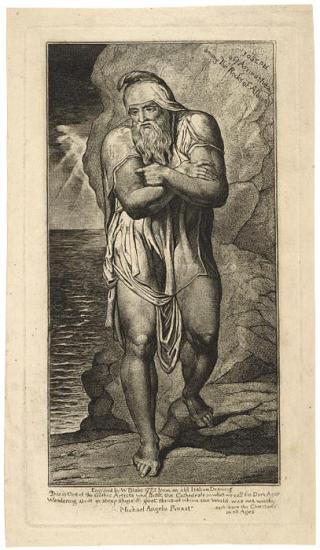
Joseph of Arimathea Among the Rocks of Albion
[London]: Engraved by W. Blake . . . , 1773
Engraving
Second state (of two), ca. 1810–20
Inscribed below the image, Engraved by W Blake 1773 from an old Italian Drawing / This is One of the Gothic Artists who Built the Cathedrals in what we call the Dark Ages / Wandering about in sheep skins & goat skins of whom the World was not worthy / such were the Christians / in all Ages / Michael Angelo Pinxit
Purchased as the gift of the Thorne Family and Fellows Fund in memory of Mrs. Landon K. Thorne, 1976
Joseph of Arimathea––the figure who is supposed to have provided Christ's funeral and perhaps later carried the Holy Grail to England––is the patron saint of gravediggers. His story surely spoke to Blake's interest in early English history and religion. He created this engraving in 1773 while still a sixteen-year-old apprentice to James Basire (1730–1802). This is the reworked state, dating from about 1810, when Blake was in his fifties.
William Blake (1757–1827) occupies a unique place in the history of Western art. His creativity included both the visual and literary arts. In his lifetime he was best known as an engraver; now he is also recognized for his innovative poetry, printmaking, and painting. Blake's keen perception of the political and social climate found expression throughout his work. His strong sense of independence is evident in the complex mythology that he constructed in response to the age of revolution.
Blake was already recognized as an engraver at age twenty-five, when his first volume of poems appeared. At thirty-three, in The Marriage of Heaven and Hell, he audaciously claimed that his birth had marked the origin of a "new heaven" in which his own art would exemplify the creativity prefigured by Milton and Michelangelo. By that time, Blake, in one of his most productive periods, had already produced Songs of Innocence and was at work on a series of illuminated books. In 1818 he met John Linnell, a young painter and engraver, through whom a group of young artists became Blake's followers. Calling themselves the Ancients, they helped perpetuate Blake's influence for generations.
The Morgan's Blake collection—one of this country's most distinguished—began with purchases as early as 1899 by Pierpont Morgan. During the tenure of Charles Ryskamp, director from 1969 to 1986, major gifts almost doubled the size of its Blake holdings. In recent years Ryskamp's own gifts of engravings, letters, and related materials have significantly enriched its scholarly resources.
I. Engravings
William Blake was tutored by his mother, given drawing lessons at the age of ten, and at fifteen apprenticed to James Basire, one of the most prominent engravers of the day. Seven years later, when the apprenticeship was complete, Blake was admitted to study at the Royal Academy. Because of this solid instruction, he was admired for his craftsmanship and often identified as "Mr. Blake, the engraver." Throughout his life, he maintained that engraving was a true art form: "Painting is Drawing on Canvas & Engraving is drawing on Copper & Nothing Else." Blake's prints demonstrate his strong commitment to line, developed through Basire and enhanced by his own creativity. Fortunately his engraver's training would support him, though not well, for the remainder of his life. At forty-six, he wrote, "I curse & bless Engraving alternately because it takes so much time & is so untractable, tho capable of such beauty & perfection."
This online exhibition is presented in conjunction with the exhibition William Blake's World: "A New Heaven Is Begun" on view September 11, 2009, through January 3, 2010.
This exhibition is made possible through the generosity of Fay and Geoffrey Elliott.
Morning Amusement
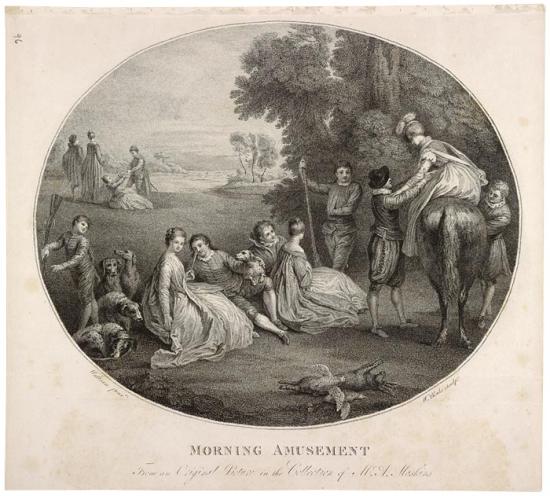
Morning Amusement
Engraving, second state
Inscribed below title, From an Original Picture in the Collection of Mr. A. Maskins.
Imprint: Pubd. August 10th 1782 by Thos. Macklin
No. 39 Fleet Street
Purchased as the gift of the Thorne Family and Fellows Fund in memory of Mrs. Landon K. Thorne, 1976
William Blake (1757–1827) occupies a unique place in the history of Western art. His creativity included both the visual and literary arts. In his lifetime he was best known as an engraver; now he is also recognized for his innovative poetry, printmaking, and painting. Blake's keen perception of the political and social climate found expression throughout his work. His strong sense of independence is evident in the complex mythology that he constructed in response to the age of revolution.
Blake was already recognized as an engraver at age twenty-five, when his first volume of poems appeared. At thirty-three, in The Marriage of Heaven and Hell, he audaciously claimed that his birth had marked the origin of a "new heaven" in which his own art would exemplify the creativity prefigured by Milton and Michelangelo. By that time, Blake, in one of his most productive periods, had already produced Songs of Innocence and was at work on a series of illuminated books. In 1818 he met John Linnell, a young painter and engraver, through whom a group of young artists became Blake's followers. Calling themselves the Ancients, they helped perpetuate Blake's influence for generations.
The Morgan's Blake collection—one of this country's most distinguished—began with purchases as early as 1899 by Pierpont Morgan. During the tenure of Charles Ryskamp, director from 1969 to 1986, major gifts almost doubled the size of its Blake holdings. In recent years Ryskamp's own gifts of engravings, letters, and related materials have significantly enriched its scholarly resources.
I. Engravings
William Blake was tutored by his mother, given drawing lessons at the age of ten, and at fifteen apprenticed to James Basire, one of the most prominent engravers of the day. Seven years later, when the apprenticeship was complete, Blake was admitted to study at the Royal Academy. Because of this solid instruction, he was admired for his craftsmanship and often identified as "Mr. Blake, the engraver." Throughout his life, he maintained that engraving was a true art form: "Painting is Drawing on Canvas & Engraving is drawing on Copper & Nothing Else." Blake's prints demonstrate his strong commitment to line, developed through Basire and enhanced by his own creativity. Fortunately his engraver's training would support him, though not well, for the remainder of his life. At forty-six, he wrote, "I curse & bless Engraving alternately because it takes so much time & is so untractable, tho capable of such beauty & perfection."
This online exhibition is presented in conjunction with the exhibition William Blake's World: "A New Heaven Is Begun" on view September 11, 2009, through January 3, 2010.
This exhibition is made possible through the generosity of Fay and Geoffrey Elliott.
Evening Amusement
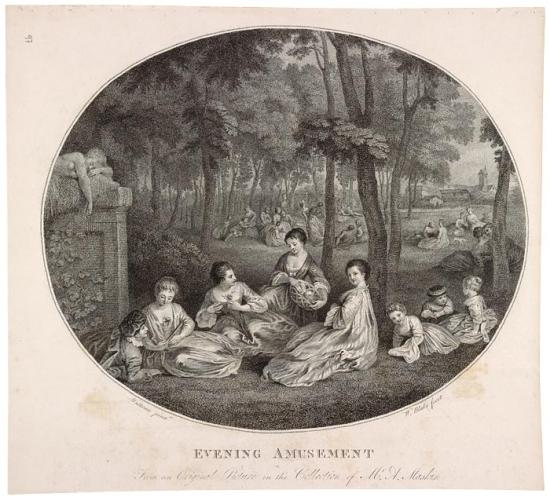
Evening Amusement
Engraving, second state
Imprint: Pubd. as the act directs August 21, 1782 by
T. Macklin, no. 39 Fleet Street
Purchased as the gift of the Thorne Family and Fellows Fund in memory of Mrs. Landon K. Thorne, 1976
Probably modified copies of Le Rendez-vous de Chasse and Les Champs Elysées, these prints were published when Blake was twenty-four years old. They were the first plates created after Blake completed his apprenticeship and demonstrate his great skill as a reproductive engraver. Nevertheless they did not win him commissions for the large print projects of the early nineteenth century. Only seven copies of Morning and six of Evening have been traced.
William Blake (1757–1827) occupies a unique place in the history of Western art. His creativity included both the visual and literary arts. In his lifetime he was best known as an engraver; now he is also recognized for his innovative poetry, printmaking, and painting. Blake's keen perception of the political and social climate found expression throughout his work. His strong sense of independence is evident in the complex mythology that he constructed in response to the age of revolution.
Blake was already recognized as an engraver at age twenty-five, when his first volume of poems appeared. At thirty-three, in The Marriage of Heaven and Hell, he audaciously claimed that his birth had marked the origin of a "new heaven" in which his own art would exemplify the creativity prefigured by Milton and Michelangelo. By that time, Blake, in one of his most productive periods, had already produced Songs of Innocence and was at work on a series of illuminated books. In 1818 he met John Linnell, a young painter and engraver, through whom a group of young artists became Blake's followers. Calling themselves the Ancients, they helped perpetuate Blake's influence for generations.
The Morgan's Blake collection—one of this country's most distinguished—began with purchases as early as 1899 by Pierpont Morgan. During the tenure of Charles Ryskamp, director from 1969 to 1986, major gifts almost doubled the size of its Blake holdings. In recent years Ryskamp's own gifts of engravings, letters, and related materials have significantly enriched its scholarly resources.
I. Engravings
William Blake was tutored by his mother, given drawing lessons at the age of ten, and at fifteen apprenticed to James Basire, one of the most prominent engravers of the day. Seven years later, when the apprenticeship was complete, Blake was admitted to study at the Royal Academy. Because of this solid instruction, he was admired for his craftsmanship and often identified as "Mr. Blake, the engraver." Throughout his life, he maintained that engraving was a true art form: "Painting is Drawing on Canvas & Engraving is drawing on Copper & Nothing Else." Blake's prints demonstrate his strong commitment to line, developed through Basire and enhanced by his own creativity. Fortunately his engraver's training would support him, though not well, for the remainder of his life. At forty-six, he wrote, "I curse & bless Engraving alternately because it takes so much time & is so untractable, tho capable of such beauty & perfection."
This online exhibition is presented in conjunction with the exhibition William Blake's World: "A New Heaven Is Begun" on view September 11, 2009, through January 3, 2010.
This exhibition is made possible through the generosity of Fay and Geoffrey Elliott.
Man Sweeping the Interpreter's Parlour
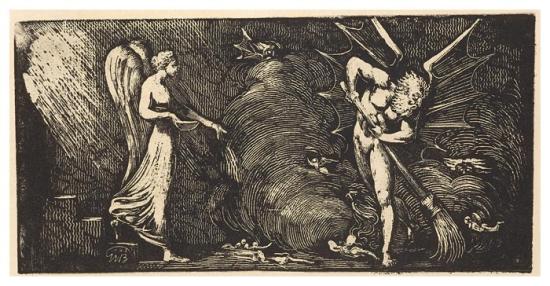
Man Sweeping the Interpreter's Parlour
White-line metalcut, printed in relief
Second state (of two), ca. 1822
Copy 2J
Gift of Mrs. Landon K. Thorne
Blake probably created this metalcut during the first half of the 1820s. This second impression is printed on paper watermarked 1821. It illustrates a story from John Bunyan's Pilgrim's Progress. The man sweeping only stirs up dust, while the woman sprinkles water to settle it and sweeten the room. The Interpreter explains that the parlour represents the heart of man, whose original sin and corruption cannot be settled by the sweeper (the law) but rather can be by the soothing blessing of the woman (the Gospel).
The theme repeats one of Blake's major beliefs that "the Letter Killeth The Spirit giveth Life" (pl. 1 of Job). The Ancients frequently called Blake "the Interpreter."
William Blake (1757–1827) occupies a unique place in the history of Western art. His creativity included both the visual and literary arts. In his lifetime he was best known as an engraver; now he is also recognized for his innovative poetry, printmaking, and painting. Blake's keen perception of the political and social climate found expression throughout his work. His strong sense of independence is evident in the complex mythology that he constructed in response to the age of revolution.
Blake was already recognized as an engraver at age twenty-five, when his first volume of poems appeared. At thirty-three, in The Marriage of Heaven and Hell, he audaciously claimed that his birth had marked the origin of a "new heaven" in which his own art would exemplify the creativity prefigured by Milton and Michelangelo. By that time, Blake, in one of his most productive periods, had already produced Songs of Innocence and was at work on a series of illuminated books. In 1818 he met John Linnell, a young painter and engraver, through whom a group of young artists became Blake's followers. Calling themselves the Ancients, they helped perpetuate Blake's influence for generations.
The Morgan's Blake collection—one of this country's most distinguished—began with purchases as early as 1899 by Pierpont Morgan. During the tenure of Charles Ryskamp, director from 1969 to 1986, major gifts almost doubled the size of its Blake holdings. In recent years Ryskamp's own gifts of engravings, letters, and related materials have significantly enriched its scholarly resources.
I. Engravings
William Blake was tutored by his mother, given drawing lessons at the age of ten, and at fifteen apprenticed to James Basire, one of the most prominent engravers of the day. Seven years later, when the apprenticeship was complete, Blake was admitted to study at the Royal Academy. Because of this solid instruction, he was admired for his craftsmanship and often identified as "Mr. Blake, the engraver." Throughout his life, he maintained that engraving was a true art form: "Painting is Drawing on Canvas & Engraving is drawing on Copper & Nothing Else." Blake's prints demonstrate his strong commitment to line, developed through Basire and enhanced by his own creativity. Fortunately his engraver's training would support him, though not well, for the remainder of his life. At forty-six, he wrote, "I curse & bless Engraving alternately because it takes so much time & is so untractable, tho capable of such beauty & perfection."
This online exhibition is presented in conjunction with the exhibition William Blake's World: "A New Heaven Is Begun" on view September 11, 2009, through January 3, 2010.
This exhibition is made possible through the generosity of Fay and Geoffrey Elliott.
Thomas Commins
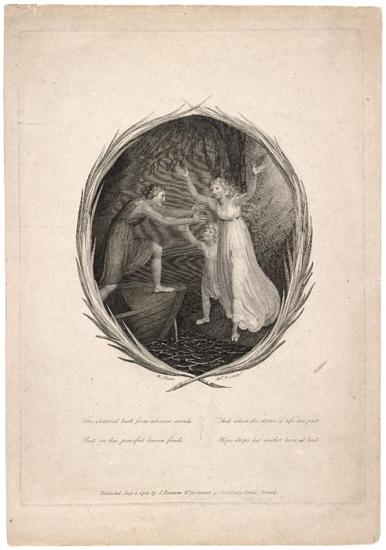
Design for the Cover Leaf of the Sheet Music An Elegy Set to Music by Thomas Commins
[London]: Published by J. Fentum, July 1, 1786
Intaglio copperplate engraving
Inscribed below image, The shatter'd bark from adverse winds / Rest in this peaceful haven finds / And when the storms of life are past / Hope drops her anchor here at last.
Gift of Charles Ryskamp in memory of Michael S. Currier
When he was about twenty-nine years old, Blake designed and engraved this cover leaf for music composed by Thomas Commins (1775–1859), the organist of Penzance, Cornwall. The stanza below the engraving is from the poem "Elegy" by Anne Home Hunter (1742–1821). The engraving depicts a returning sailor lunging into the welcoming arms of his wife and child. Only two or three copies are known.
William Blake (1757–1827) occupies a unique place in the history of Western art. His creativity included both the visual and literary arts. In his lifetime he was best known as an engraver; now he is also recognized for his innovative poetry, printmaking, and painting. Blake's keen perception of the political and social climate found expression throughout his work. His strong sense of independence is evident in the complex mythology that he constructed in response to the age of revolution.
Blake was already recognized as an engraver at age twenty-five, when his first volume of poems appeared. At thirty-three, in The Marriage of Heaven and Hell, he audaciously claimed that his birth had marked the origin of a "new heaven" in which his own art would exemplify the creativity prefigured by Milton and Michelangelo. By that time, Blake, in one of his most productive periods, had already produced Songs of Innocence and was at work on a series of illuminated books. In 1818 he met John Linnell, a young painter and engraver, through whom a group of young artists became Blake's followers. Calling themselves the Ancients, they helped perpetuate Blake's influence for generations.
The Morgan's Blake collection—one of this country's most distinguished—began with purchases as early as 1899 by Pierpont Morgan. During the tenure of Charles Ryskamp, director from 1969 to 1986, major gifts almost doubled the size of its Blake holdings. In recent years Ryskamp's own gifts of engravings, letters, and related materials have significantly enriched its scholarly resources.
I. Engravings
William Blake was tutored by his mother, given drawing lessons at the age of ten, and at fifteen apprenticed to James Basire, one of the most prominent engravers of the day. Seven years later, when the apprenticeship was complete, Blake was admitted to study at the Royal Academy. Because of this solid instruction, he was admired for his craftsmanship and often identified as "Mr. Blake, the engraver." Throughout his life, he maintained that engraving was a true art form: "Painting is Drawing on Canvas & Engraving is drawing on Copper & Nothing Else." Blake's prints demonstrate his strong commitment to line, developed through Basire and enhanced by his own creativity. Fortunately his engraver's training would support him, though not well, for the remainder of his life. At forty-six, he wrote, "I curse & bless Engraving alternately because it takes so much time & is so untractable, tho capable of such beauty & perfection."
This online exhibition is presented in conjunction with the exhibition William Blake's World: "A New Heaven Is Begun" on view September 11, 2009, through January 3, 2010.
This exhibition is made possible through the generosity of Fay and Geoffrey Elliott.
Satan
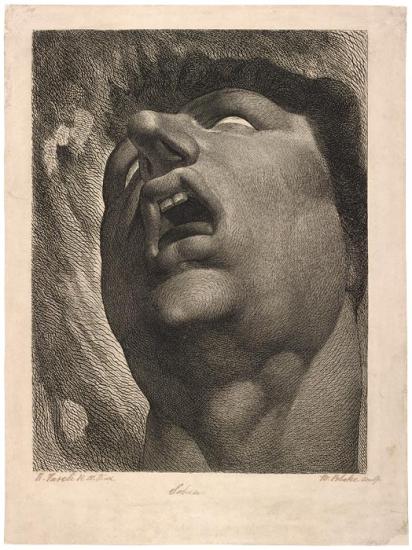
Satan
Inscribed below in pen and ink, H. Fuseli R. A. Pi Satan W. Blake sculp.
Gift of Charles Ryskamp in memory of Sir Geoffrey Keynes
This hideous head of a man howling in torment is also known as "Head of a Damned Soul in Dante's Inferno." Impressions of the print are very rare—only five known proofs of a single state are extant—and the general lack of lettering on known examples suggests that the print was never properly published.
Blake likely executed this large-scale print ca. 1790 as an experiment to entertain his friend Henry Fuseli. This copy once belonged to the great Blake scholar Sir Geoffrey Keynes (1887–1982), who gave it to his friend Charles Ryskamp.
William Blake (1757–1827) occupies a unique place in the history of Western art. His creativity included both the visual and literary arts. In his lifetime he was best known as an engraver; now he is also recognized for his innovative poetry, printmaking, and painting. Blake's keen perception of the political and social climate found expression throughout his work. His strong sense of independence is evident in the complex mythology that he constructed in response to the age of revolution.
Blake was already recognized as an engraver at age twenty-five, when his first volume of poems appeared. At thirty-three, in The Marriage of Heaven and Hell, he audaciously claimed that his birth had marked the origin of a "new heaven" in which his own art would exemplify the creativity prefigured by Milton and Michelangelo. By that time, Blake, in one of his most productive periods, had already produced Songs of Innocence and was at work on a series of illuminated books. In 1818 he met John Linnell, a young painter and engraver, through whom a group of young artists became Blake's followers. Calling themselves the Ancients, they helped perpetuate Blake's influence for generations.
The Morgan's Blake collection—one of this country's most distinguished—began with purchases as early as 1899 by Pierpont Morgan. During the tenure of Charles Ryskamp, director from 1969 to 1986, major gifts almost doubled the size of its Blake holdings. In recent years Ryskamp's own gifts of engravings, letters, and related materials have significantly enriched its scholarly resources.
I. Engravings
William Blake was tutored by his mother, given drawing lessons at the age of ten, and at fifteen apprenticed to James Basire, one of the most prominent engravers of the day. Seven years later, when the apprenticeship was complete, Blake was admitted to study at the Royal Academy. Because of this solid instruction, he was admired for his craftsmanship and often identified as "Mr. Blake, the engraver." Throughout his life, he maintained that engraving was a true art form: "Painting is Drawing on Canvas & Engraving is drawing on Copper & Nothing Else." Blake's prints demonstrate his strong commitment to line, developed through Basire and enhanced by his own creativity. Fortunately his engraver's training would support him, though not well, for the remainder of his life. At forty-six, he wrote, "I curse & bless Engraving alternately because it takes so much time & is so untractable, tho capable of such beauty & perfection."
This online exhibition is presented in conjunction with the exhibition William Blake's World: "A New Heaven Is Begun" on view September 11, 2009, through January 3, 2010.
This exhibition is made possible through the generosity of Fay and Geoffrey Elliott.
Chaucer's Canterbury Pilgrims
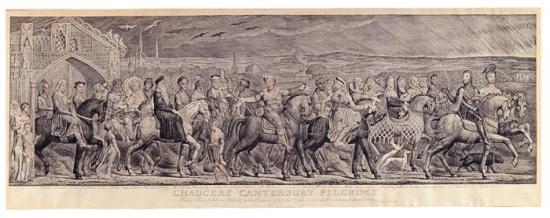
Chaucer's Canterbury Pilgrims
Copper engraving, with additions in watercolor by the artist
Third state, 1810–20
Copy 3P
Signature and imprint, Painted in Fresco by William Blake & by him Engraved & Published October 8. 1810, at No 28. Corner of Broad Street Golden Square; inscribed below: Chaucers Canterbury Pilgrims, and with the names of the pilgrims, Reeve, Chaucer, Clerk of Oxenford, Cook, Miller, Wife of Bath, Merchant, Parson, Man of Law, Plowman, Physician, Franklin, 2 Citizens, Shipman, The Host, Sompnour, Manciple, Pardoner, Monk, Friar, a Citizen, Lady Abbess, Nun, 3 Priests, Squires, Yeoman, Knight, Squire.
Gift of Charles Ryskamp in memory of Grace Lansing Lambert
This is a magnificent example of Blake's largest print, one of only three known impressions to which he added watercolor. The engraving is known in five states, and the present sheet is the only hand-colored example of the third state of the image. Blake's use of line engraving, emulating the styles of early printmakers Albrecht Dürer and Lucas van Leyden, evokes the character of Chaucer's poetry.
Blake painted the pilgrims after a quarrel with R. H. Cromek and Thomas Stothard regarding whether the commission had originally been Blake's. The painting was exhibited at his brother's Soho shop in 1809, and this engraving was created from it.
William Blake (1757–1827) occupies a unique place in the history of Western art. His creativity included both the visual and literary arts. In his lifetime he was best known as an engraver; now he is also recognized for his innovative poetry, printmaking, and painting. Blake's keen perception of the political and social climate found expression throughout his work. His strong sense of independence is evident in the complex mythology that he constructed in response to the age of revolution.
Blake was already recognized as an engraver at age twenty-five, when his first volume of poems appeared. At thirty-three, in The Marriage of Heaven and Hell, he audaciously claimed that his birth had marked the origin of a "new heaven" in which his own art would exemplify the creativity prefigured by Milton and Michelangelo. By that time, Blake, in one of his most productive periods, had already produced Songs of Innocence and was at work on a series of illuminated books. In 1818 he met John Linnell, a young painter and engraver, through whom a group of young artists became Blake's followers. Calling themselves the Ancients, they helped perpetuate Blake's influence for generations.
The Morgan's Blake collection—one of this country's most distinguished—began with purchases as early as 1899 by Pierpont Morgan. During the tenure of Charles Ryskamp, director from 1969 to 1986, major gifts almost doubled the size of its Blake holdings. In recent years Ryskamp's own gifts of engravings, letters, and related materials have significantly enriched its scholarly resources.
I. Engravings
William Blake was tutored by his mother, given drawing lessons at the age of ten, and at fifteen apprenticed to James Basire, one of the most prominent engravers of the day. Seven years later, when the apprenticeship was complete, Blake was admitted to study at the Royal Academy. Because of this solid instruction, he was admired for his craftsmanship and often identified as "Mr. Blake, the engraver." Throughout his life, he maintained that engraving was a true art form: "Painting is Drawing on Canvas & Engraving is drawing on Copper & Nothing Else." Blake's prints demonstrate his strong commitment to line, developed through Basire and enhanced by his own creativity. Fortunately his engraver's training would support him, though not well, for the remainder of his life. At forty-six, he wrote, "I curse & bless Engraving alternately because it takes so much time & is so untractable, tho capable of such beauty & perfection."
This online exhibition is presented in conjunction with the exhibition William Blake's World: "A New Heaven Is Begun" on view September 11, 2009, through January 3, 2010.
This exhibition is made possible through the generosity of Fay and Geoffrey Elliott.
Portrait of Wilson Lowry
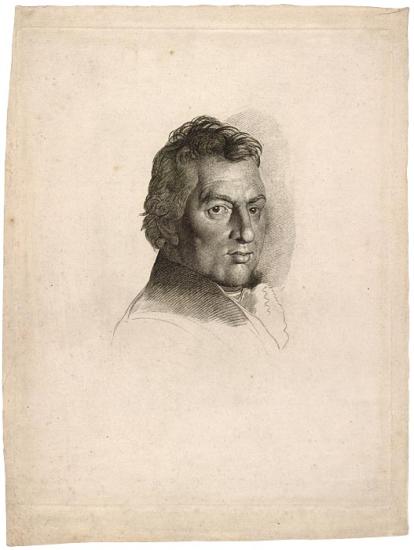
Portrait of Wilson Lowry
Engraving with traces of graphite
Second state (of five), 1824–25
Gift of Charles Ryskamp in memory of Michael S. Currier
This portrait––one of only two impressions of this second state––depicts Wilson Lowry (1762–1824), a British engraver and illustrator who developed several printing innovations, including the corrosive solution used to etch lines into steel plates. The inscription on the fourth state reads Drawn from Life by J. Linnell, & Engraved by J. Linnell, & W. Blake. By the time that Blake was at work on his Job engravings, he had acquired many of Linnell's engraving techniques, so their styles meshed smoothly. The traces of graphite might indicate Blake's corrections for a subsequent state.
William Blake (1757–1827) occupies a unique place in the history of Western art. His creativity included both the visual and literary arts. In his lifetime he was best known as an engraver; now he is also recognized for his innovative poetry, printmaking, and painting. Blake's keen perception of the political and social climate found expression throughout his work. His strong sense of independence is evident in the complex mythology that he constructed in response to the age of revolution.
Blake was already recognized as an engraver at age twenty-five, when his first volume of poems appeared. At thirty-three, in The Marriage of Heaven and Hell, he audaciously claimed that his birth had marked the origin of a "new heaven" in which his own art would exemplify the creativity prefigured by Milton and Michelangelo. By that time, Blake, in one of his most productive periods, had already produced Songs of Innocence and was at work on a series of illuminated books. In 1818 he met John Linnell, a young painter and engraver, through whom a group of young artists became Blake's followers. Calling themselves the Ancients, they helped perpetuate Blake's influence for generations.
The Morgan's Blake collection—one of this country's most distinguished—began with purchases as early as 1899 by Pierpont Morgan. During the tenure of Charles Ryskamp, director from 1969 to 1986, major gifts almost doubled the size of its Blake holdings. In recent years Ryskamp's own gifts of engravings, letters, and related materials have significantly enriched its scholarly resources.
I. Engravings
William Blake was tutored by his mother, given drawing lessons at the age of ten, and at fifteen apprenticed to James Basire, one of the most prominent engravers of the day. Seven years later, when the apprenticeship was complete, Blake was admitted to study at the Royal Academy. Because of this solid instruction, he was admired for his craftsmanship and often identified as "Mr. Blake, the engraver." Throughout his life, he maintained that engraving was a true art form: "Painting is Drawing on Canvas & Engraving is drawing on Copper & Nothing Else." Blake's prints demonstrate his strong commitment to line, developed through Basire and enhanced by his own creativity. Fortunately his engraver's training would support him, though not well, for the remainder of his life. At forty-six, he wrote, "I curse & bless Engraving alternately because it takes so much time & is so untractable, tho capable of such beauty & perfection."
This online exhibition is presented in conjunction with the exhibition William Blake's World: "A New Heaven Is Begun" on view September 11, 2009, through January 3, 2010.
This exhibition is made possible through the generosity of Fay and Geoffrey Elliott.